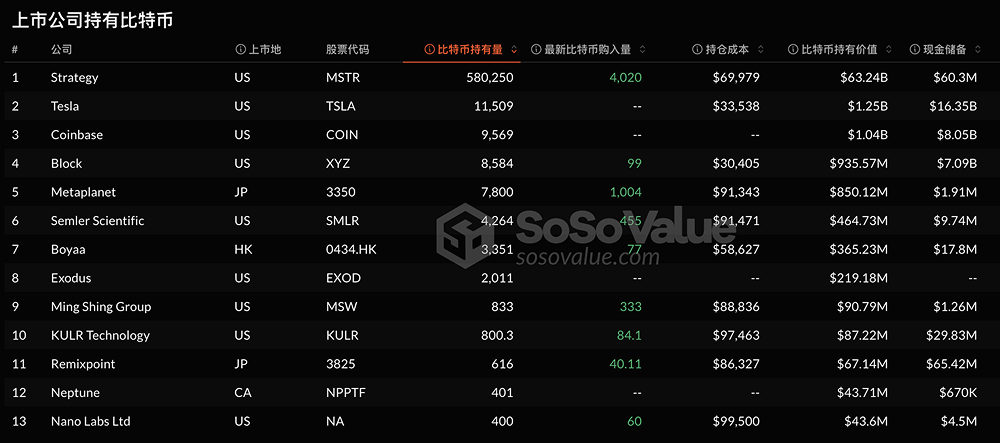On May 25 local time, Michael Saylor once again announced the "Bitcoin War Report": Strategy Company purchased an additional 4,020 BTC in the second quarter of 2025, totaling approximately $427.1 million, with a cost per coin of $106,237. Including previous holdings, Strategy now holds a total of 580,250 BTC, with a cumulative investment amount reaching $40.61 billion and an average cost of $69,979.

The news caused a stir in the community. Some called it the "strongest Bitcoin buyer," while others shouted "faith recharge continues," but those who remained calm noticed that this seemingly bold investment is bringing the entire Bitcoin financial structure closer to the critical point of a leveraged collapse.
1. It's not about buying coins, but burning money to "refine leverage"
In the impression of most people, Strategy is a Bitcoin "vault," essentially a "quasi-ETF type" company—buying BTC and waiting for the price to rise. However, in reality, it is a complex and dangerous financial leverage machine.
It does not buy coins with profits but finances the purchase of BTC through continuous issuance of new shares (ATM), convertible bonds, preferred stocks, and other means.
The core of this model is not investment but creating a perpetual motion machine-like flywheel:
Stock price rises → Can issue shares at a higher premium → Raise more money to buy BTC → BTC rises → Stock price continues to rise → Flywheel spins faster
But the key driving force of this flywheel is an indicator called mNAV (market Net Asset Value): that is, Strategy's current stock price / the market value of BTC represented by each share.
As long as mNAV > 1, the company can "issue shares at a premium," exchanging a higher valuation for cash. But once mNAV < 1, the flywheel will lose fuel, and the risk of the entire structure will erupt like a flash flood.

2. Analysis of the "toxic leverage" structure
Behind this round of $400 million increase, the specific financing methods used by Strategy have not been disclosed, but historically, its "funding arsenal" includes the following:
1. ATM issuance (continuously selling shares at market price)
This is currently the most frequently used method. Once the market is optimistic and the stock price rises, the company can issue shares at a high price to quickly raise funds to buy BTC.
The problem is that every issuance of shares dilutes the original shareholders. If there is no continuous rise in BTC to support it, this dilution will become increasingly unsustainable.
2. Convertible bonds: betting on future valuations
Strategy has issued approximately $8.2 billion in convertible bonds. These bonds must be converted into shares based on the condition that "the stock price reaches a certain conversion price." If the stock price fails to meet the conversion conditions, the company must either repurchase the bonds or be forced to sell BTC to repay principal and interest.
The triggering conditions are still based on mNAV—a "illusory indicator" driven by market sentiment.
3. Preferred stocks: high-interest liabilities that are never redeemed
STRF (Strategy Risk-Free) is a type of preferred stock issued by the company with an annualized interest rate of 10%. Although packaged as a "fixed income BTC exposure product," it is essentially a permanent cash flow liability.
The only way to maintain this payment capability is to continuously dilute common shareholders, using "future investors' money" to pay "today's investors' returns."
This is a classic characteristic of a Ponzi structure.
3. Everything relies on the "faith" indicator: mNAV
Let's do a simple deduction:
Assuming BTC remains flat, and Strategy's holdings do not rise or fall;
Shareholders still need to receive interest (preferred stock), and bonds need to be repaid (convertible bonds);
The company can only "find money" by selling shares or selling BTC.
At this point, if market sentiment cools and mNAV falls below 1, the company will be unable to raise funds through new shares. This means:
Unable to buy coins → Asset growth stagnates → Investors become disappointed → Stock price falls → mNAV further declines → Flywheel completely stalls
At that time, the company will have to make the worst choice: sell BTC to pay off debts. This will create market selling pressure while further impacting mNAV.
This closed loop is called the "death spiral."
4. Strategy is not an ETF, but a risk packaging machine
Unlike closed-end funds like GBTC, Strategy's stock price is not tied to the actual price of BTC.
Its value does not directly reflect net asset value but is driven by numerous market factors—premium expectations, leverage structure, Saylor's own influence, and more.
When investors begin to realize that the stocks they hold are not BTC itself but a game built on "selling shares to buy coins and then selling shares," the bubble will burst quickly.
We can learn from the history of GBTC:
During the bull market in 2021, GBTC once traded at a premium of up to 30%. However, with the launch of BTC ETFs and the increase in alternative channels, the demand for GBTC disappeared, quickly falling into a discount trap and ultimately being forced to transform.
A similar fate may await Strategy: as more Bitcoin spot ETFs emerge, investors will gradually realize that they do not need to gain BTC exposure through "a highly leveraged company."

5. Where is the endpoint of Strategy's "BTC plan"?
Michael Saylor has publicly stated that his goal is to push the Bitcoin reserve scale to millions of coins through the issuance of trillions of dollars in preferred stocks, debts, and other forms.
This sounds like the construction of a financial empire. But according to the current 10% annual interest preferred stock model:
If $3 trillion in debt is issued, $300 billion in interest will be needed each year;
Even if the price of BTC rises in the future, the company must continuously dilute equity or cash out BTC to maintain cash flow;
The overall risk exposure far exceeds that of any real entity in traditional financial markets.
In other words: this is not about reserving Bitcoin, but about betting the future interests of shareholders on the continued bull market of Bitcoin.
In conclusion: The faith in Bitcoin should not be built on a sand pile of leverage
Strategy's frenzied buying behavior has excited many investors, but if we strip away the emotions, we find that this is actually a large financial experiment: how to use equity leverage to create a company-level BTC hedge fund.
But as the 2008 financial crisis taught us—any structure built on high leverage and market sentiment can collapse with just a slight disturbance.
The original intention of Bitcoin is to oppose excessive financialization and credit expansion. Today, a company is using BTC as collateral to start the game most familiar to Wall Street.
It will ultimately return to fundamentals—not the flywheel, not faith, and not Michael Saylor's tweets.
This article only represents the author's personal views and does not represent the position and views of this platform. This article is for information sharing only and does not constitute any investment advice to anyone.
Join our community to discuss this event
Official Telegram community: t.me/aicoincn
Chat room: Wealth Group
免责声明:本文章仅代表作者个人观点,不代表本平台的立场和观点。本文章仅供信息分享,不构成对任何人的任何投资建议。用户与作者之间的任何争议,与本平台无关。如网页中刊载的文章或图片涉及侵权,请提供相关的权利证明和身份证明发送邮件到support@aicoin.com,本平台相关工作人员将会进行核查。




